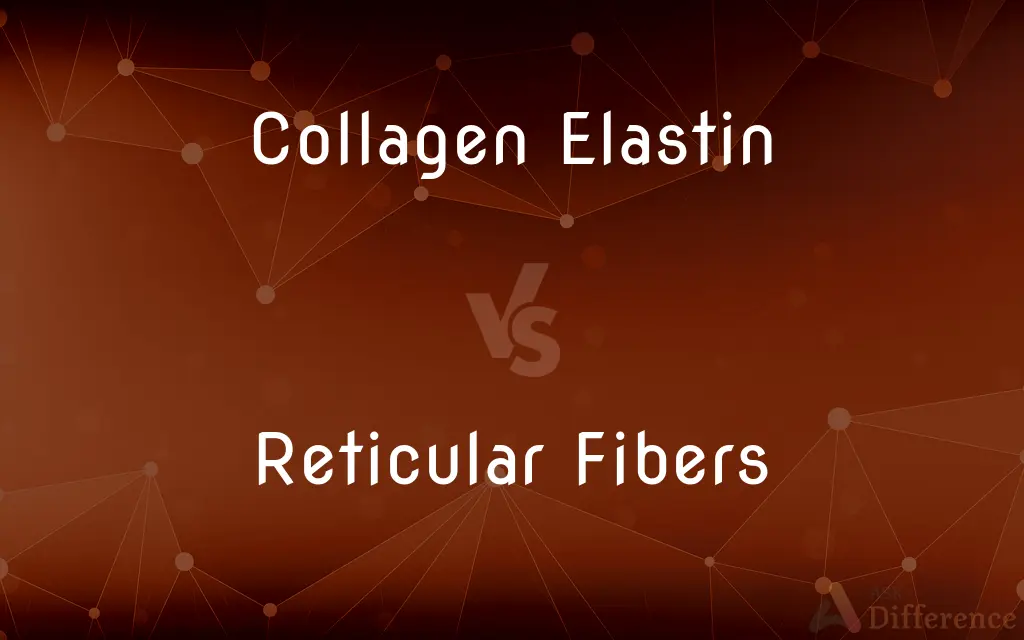Collagen Elastin vs. Reticular Fibers — What's the Difference?
By Urooj Arif & Fiza Rafique — Published on December 16, 2024
Collagen and elastin provide strength and elasticity to tissues, whereas reticular fibers form a supportive mesh in soft tissues.

Difference Between Collagen Elastin and Reticular Fibers
Table of Contents
ADVERTISEMENT
Key Differences
Collagen elastin refers to fibers in the body that give structure, strength, and elasticity to skin and connective tissues. These fibers are crucial for maintaining the skin's youthful appearance and the flexibility of joints and tendons. On the other hand, reticular fibers, composed mainly of type III collagen, create a fine network that supports cells in various organs, such as the spleen, lymph nodes, and bone marrow. This mesh-like structure is essential for the filtration and support of cells within these organs.
Collagen and elastin fibers are known for their large diameters, providing tensile strength and elasticity, respectively, while reticular fibers are much thinner, forming a delicate network. This difference in structure allows reticular fibers to support the soft tissue architecture within organs, whereas collagen and elastin contribute to the overall physical properties of connective tissues, such as skin, tendons, and ligaments.
In terms of function, collagen and elastin are primarily responsible for resisting mechanical forces and maintaining the integrity of tissues during movement. Conversely, reticular fibers play a critical role in supporting the cellular components of the immune system and facilitating the filtration of substances in lymphatic and blood vessels.
Collagen and elastin fibers are abundant in tissues that require strength and flexibility, such as the skin, lungs, and arterial walls. Reticular fibers, however, are found in organs where cell support and filtration are necessary, emphasizing their role in the immune system and blood formation.
Despite their different roles, both collagen elastin and reticular fibers are essential for the proper functioning of the body's connective tissue system. They work in tandem to provide mechanical support, elasticity, and a supportive framework for cells, highlighting the complexity and specialization of the body's extracellular matrix components.
ADVERTISEMENT
Comparison Chart
Composition
Primarily type I collagen and elastin
Mainly type III collagen
Function
Provide strength and elasticity
Supportive mesh for soft tissues
Location
Skin, tendons, ligaments
Spleen, lymph nodes, bone marrow
Diameter
Large
Thin
Role in Body
Resist mechanical forces, maintain tissue integrity
Support cellular components, facilitate filtration
Compare with Definitions
Collagen Elastin
Essential for the proper functioning of connective tissues, they play a key role in the body's overall health and mechanical efficiency.
A diet rich in vitamin C supports the synthesis of collagen elastin, promoting skin health.
Reticular Fibers
Predominantly found in the spleen, lymph nodes, and bone marrow, they play a critical role in the immune system and hematopoiesis.
Reticular fibers in lymph nodes provide a structure for lymphocyte migration and function.
Collagen Elastin
Collagen elastin fibers are structural proteins that provide strength, elasticity, and resilience to various tissues.
The skin's ability to return to its original shape after being stretched is due to collagen elastin.
Reticular Fibers
They support cellular components of the immune system and facilitate the filtration of substances within the lymphatic and blood vessels.
Reticular fibers in the liver help in filtering toxins from the blood.
Collagen Elastin
These fibers are crucial in maintaining the youthful appearance and flexibility of the skin and connective tissues.
Regular exercise can help maintain the integrity of collagen elastin in joints.
Reticular Fibers
Reticular fibers are thin, type III collagen fibers that form a supportive mesh in various organs, facilitating cell support and substance filtration.
Reticular fibers in the spleen filter blood, removing old red blood cells.
Collagen Elastin
They resist mechanical forces, ensuring the tissues can withstand stretching and bending without damage.
Collagen elastin in the skin absorbs impact and pressure, preventing injuries.
Reticular Fibers
Vital for the structure and function of soft tissues in organs, their presence ensures the proper operation of immune and filtration systems.
A healthy immune response is often attributed to the effective functioning of reticular fiber-supported organs.
Collagen Elastin
Found in high concentrations within the skin, lungs, and arterial walls, these fibers support and protect these organs.
Aging leads to the reduction of collagen elastin in the skin, resulting in wrinkles.
Reticular Fibers
These delicate fibers create a scaffold that supports the soft tissue architecture within organs.
The bone marrow's ability to produce blood cells is supported by a network of reticular fibers.
Common Curiosities
What are collagen elastin fibers?
Collagen elastin fibers are structural proteins that provide strength and elasticity to the skin and connective tissues.
Where are reticular fibers found?
Reticular fibers are found in organs like the spleen, lymph nodes, and bone marrow, providing a supportive mesh.
What role do reticular fibers play in the immune system?
They support cellular components of the immune system, facilitating efficient immune responses.
Why are collagen elastin important for the skin?
They maintain the skin's strength, elasticity, and youthful appearance by allowing it to stretch and return to its original shape.
Can the body produce collagen elastin and reticular fibers throughout life?
Yes, but the production decreases with age, affecting the skin's elasticity and the efficiency of the immune system.
How do collagen and elastin differ from reticular fibers in function?
Collagen and elastin provide structural support and elasticity, whereas reticular fibers form a supportive network for cells in soft tissues.
What is the primary difference in the composition of collagen elastin and reticular fibers?
Collagen elastin is primarily composed of type I collagen and elastin, whereas reticular fibers are mainly made of type III collagen.
Can collagen elastin and reticular fibers be repaired once damaged?
The body can repair and regenerate these fibers to some extent, but the efficiency decreases with age.
Are reticular fibers visible under a standard microscope?
Yes, but they are best observed with special staining techniques due to their delicate structure.
How do aging processes affect collagen elastin and reticular fibers?
Aging reduces the production of these fibers, leading to decreased skin elasticity and compromised immune function.
Can diet and lifestyle impact the health of collagen elastin and reticular fibers?
Yes, a healthy diet, avoiding excessive sun exposure, and regular exercise can support the health and production of these fibers.
How do diseases affect collagen elastin and reticular fibers?
Certain diseases can degrade these fibers, leading to weakened connective tissues and compromised organ support.
What medical treatments target collagen elastin and reticular fibers?
Treatments like laser therapy and collagen supplements aim to enhance the function and appearance of tissues rich in these fibers.
Is it possible to enhance the production of collagen elastin in the body?
Yes, through a balanced diet, specific supplements, and skincare routines that promote collagen synthesis.
How do collagen elastin and reticular fibers interact within the body?
They function in tandem to provide structural support, elasticity, and a supportive framework for cellular components across various tissues.
Share Your Discovery

Previous Comparison
Apocrine Sweat Glands vs. Merocrine Sweat Glands
Next Comparison
Embedding vs. ImbeddingAuthor Spotlight
Written by
Urooj ArifUrooj is a skilled content writer at Ask Difference, known for her exceptional ability to simplify complex topics into engaging and informative content. With a passion for research and a flair for clear, concise writing, she consistently delivers articles that resonate with our diverse audience.
Co-written by
Fiza RafiqueFiza Rafique is a skilled content writer at AskDifference.com, where she meticulously refines and enhances written pieces. Drawing from her vast editorial expertise, Fiza ensures clarity, accuracy, and precision in every article. Passionate about language, she continually seeks to elevate the quality of content for readers worldwide.














































